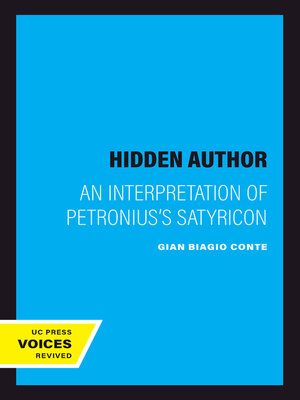The Hidden Author
ebook ∣ An Interpretation of Petronius's Satyricon · Sather Classical Lectures
By Gian Biagio Conte

Sign up to save your library
With an OverDrive account, you can save your favorite libraries for at-a-glance information about availability. Find out more about OverDrive accounts.
Find this title in Libby, the library reading app by OverDrive.



Search for a digital library with this title
Title found at these libraries:
| Library Name | Distance |
|---|---|
| Loading... |
The Satyricon of Petronius, a comic novel written in the first century A.D., is famous today primarily for its amazing banquet tale, "Trimalchio's Feast." But this episode is only one part of the larger picture of life during Nero's rule presented in the work. In this accessible discussion of Petronius's masterful use of parody, Gian Biagio Conte offers an interpretation of the Satyricon as a whole. He combines the scholarly precision of close reading with a significant, original theoretical model.
At the heart of his interpretation, Conte reveals the technique of the "hidden author" that Petronius employs at the expense of his characters, in particular the teller of the story, Enclopius. By remaining hidden outside the narrative, Petronius invites the reader to smile at the folies de grandeur that occur in a culture of scholars and declaimers. Yet as Conte shows, behind the parody and inexhaustible humor of the Satyricon lies an unexpectedly serious lament. For those familiar with the Satyricon, as well as for new readers, Conte's book will be a reliable, enjoyable guide to the wonders the Satyricon contains.
The Satyricon of Petronius, a comic novel written in the first century A.D., is famous today primarily for its amazing banquet tale, "Trimalchio's Feast." But this episode is only one part of the larger picture of life during Nero's rule presented in the
At the heart of his interpretation, Conte reveals the technique of the "hidden author" that Petronius employs at the expense of his characters, in particular the teller of the story, Enclopius. By remaining hidden outside the narrative, Petronius invites the reader to smile at the folies de grandeur that occur in a culture of scholars and declaimers. Yet as Conte shows, behind the parody and inexhaustible humor of the Satyricon lies an unexpectedly serious lament. For those familiar with the Satyricon, as well as for new readers, Conte's book will be a reliable, enjoyable guide to the wonders the Satyricon contains.
The Satyricon of Petronius, a comic novel written in the first century A.D., is famous today primarily for its amazing banquet tale, "Trimalchio's Feast." But this episode is only one part of the larger picture of life during Nero's rule presented in the







